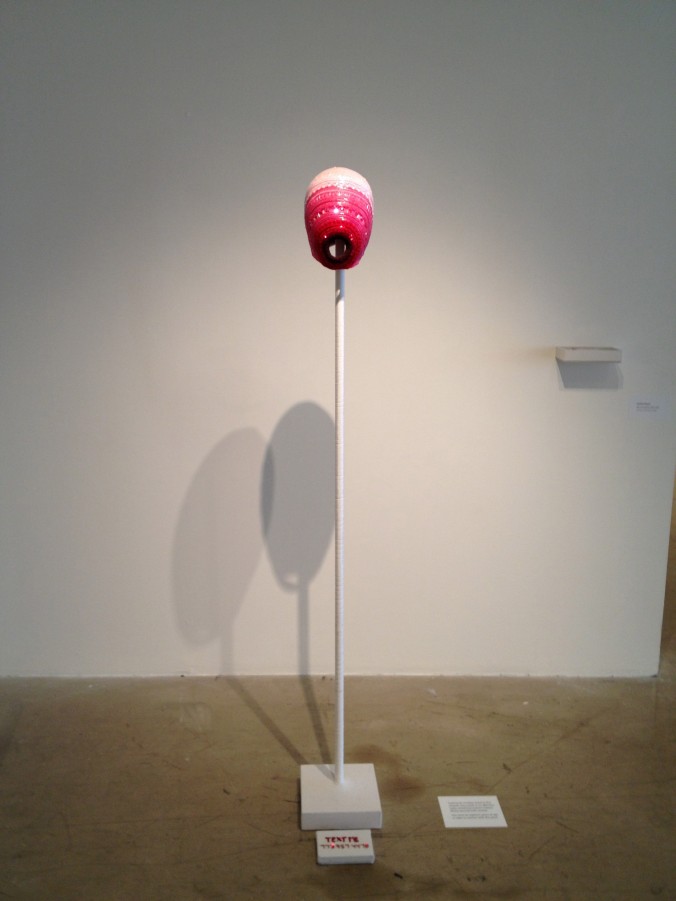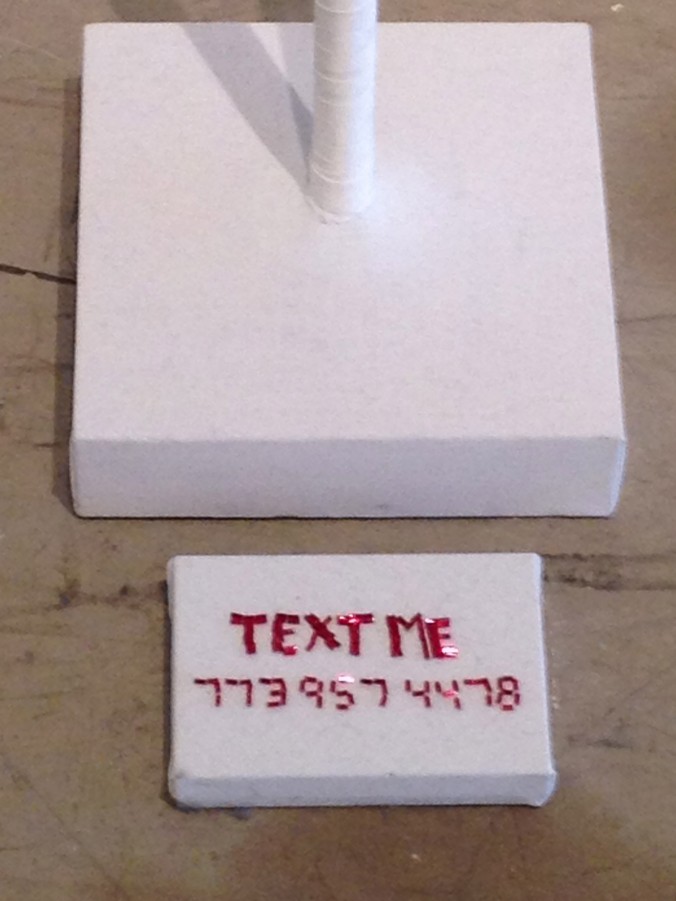
Under what circumstances is it appropriate for SAIC to ask a student to change work exhibited on campus? Art that causes controversy is not new to SAIC. By now we all know the story of the Harold Washington painting by former SAIC student David Nelson and “What is the Proper Way to Display the U.S. Flag?” by Dread Scott Tyler. The school stood behind Tyler and suffered significant financial cuts in both government and private funding because of it. In both cases the work outraged communities outside SAIC. So, understandably, there is always concern around work that may be offensive or illegal.
For what other reasons might the school request alterations? Now consider the case of Caroline Wayne, a BFA candidate in the Fiber and Material Studies, whose work was altered during the course of the 2013 BFA exhibition, to protect, according to the school, her safety.
Wayne’s specialties are soft sculpture and hat-making, which sound innocuous enough. However, Wayne’s work doesn’t stop at object creation; she is also interested in issues of intimacy and social interaction and how relationships are altered by technological innovation.
Her contribution to the BFA exhibition, titled, “Was it Something I Said?” included a headpiece at the base of which was a phone number stitched in red thread underneath the provocation “text me.” When an audience member followed the instructions and texted the number, Wayne would respond by aggressively attempting to initiate a sexting conversation. She would also include a provocative image of herself with her face covered.
Wayne took steps to ensure that her identity and personal contact information were obscured, including purchasing a burn phone and paying for one month of a pre-paid phone plan that she would use only for the duration of this project. She set guidelines for herself, including having no in-person contact with audience members and terminating all communication at the end of the exhibition.
After the BFA exhibition opening, according to the school, an audience member complained after texting the number and receiving Wayne’s response. In reaction to the complaint, the school posted an audience warning next to the piece and spoke with Wayne during a meeting she had arranged with the Career and Co-op Center. During that meeting, Wayne; Kate Schutta, Assistant Dean of Student Affairs and Co-director of the Career + Co-op Center; and Amy Dane Falkowski, Associate Dean of Budget and Administration discussed their concerns for Caroline’s personal safety. They asked Wayne to file a form with the school for approval of the work.
F Newsmagazine met with Amy Dane Falkowski, who is involved in a new initiative at SAIC called Art School Considerations, as well as the Threat Assessment Group (TAG), which is why she was elected to meet with Wayne initially. She pointed out that Wayne’s identity was readily available online with an easy Internet search, which Falkowski considered the most serious concern.

Art School Considerations (ASC) is a structure devised by the school, seemingly to avoid messy situations such as the Nelson and Tyler controversies mentioned above, but also to help students understand the potentially negative personal or ethical impact of their work. A poster that can be found around campus for the group features the motto, “It’s Not ‘No,’ ‘It’s How.’” Their list of items and situations that need prior approval includes foods, liquids and controlled substances; chemicals and hazardous materials; biomatter, bloodborne pathogens and organic materials; performances; weapons, structures and kinetics; electric and sound levels; alternative spaces; fire and safety; community and courtesy; anything you are unsure about. A formidable list.
Still, Falkowski insisted that ASC is meant to help students, not hinder them. She offered examples of situations in which ASC aided students in the completion of their projects in a way that ensured their safety, as when a student wanted to climb the walls during an exhibition and the group helped determine the safest way for the student to accomplish that goal. Other than Wayne’s case, which was brought to ASC after the fact, Falkowski could only think of one situation in which a student’s proposal was denied, and that was because the student submitted it the day before the exhibition, not leaving adequate time to assure its safe execution.
Wayne did not know about Art School Considerations before exhibiting “Was it Something I Said?” Falkowski said that if she had asked one of the Student Project Coordinators about the piece, they would have been able to find a way to make the project happen in a way that was acceptable for Wayne and the school.
However, because it was too late to ensure complete anonymity for Wayne, ultimately her situation was brought to TAG and she was asked to remove the texting portion of her piece. “If we had had a conversation early on, we would have been able to make sure that she was covering all of her bases,” Falkowski said.
Additionally, the school asked for the SIM card of the prepaid phone that Wayne had been using to converse with participants. Although she agreed with all of the requests, Wayne still feels uncomfortable about the incident, and says she only handed over the phone in order to avoid a controversy so close to her graduation. “I did voice that I was uncomfortable with giving over my SIM card and letting them read through my conversations, to which they responded that they have the same right as they do to go through faculty’s e-mails,” Wayne explained.
“There was an implied risk that I thought was important to demonstrate,” Wayne insists. “While the school has its concerns, I am over the age of 18 and feel that I should have had my opportunity to speak about the reality of virtual self-exploitation.”
When asked what steps would have been taken if Wayne hadn’t agreed to alter her work, Falkowski explained that since it was primarily a student safety concern, Wayne’s emergency contacts would have been notified. “That would mean calling my parents, and as a 28-year-old that makes me a little uncomfortable. … I would certainly feel diminished and not trusted as an artist and an adult,” Wayne said.
While it is too late for Wayne’s piece to be exhibited in full, this case highlights important tensions between acceptable risk at an educational institution. Art School Considerations seems to be trying to function in a gray area between unrestricted creation, vital for some art practices, and unacceptable hazards for an institution. This can become problematic in situations like Wayne’s when the hazard, to some degree, is the point. Additionally, repression of female sexuality and autonomy have long been restricted in the U.S. on the pretext of concern for a woman’s safety. The history of institutional and self-censorship in the arts, especially after the Culture Wars of the 1980s, makes it imperative that the reasons for altering work are thoroughly analyzed. Although censorship was not the school’s intention, careful analysis of the kinds of suggested changes and the real reasons behind those suggestions needs to be discussed.

“I think it is important to think about why you are making the point you are when you make a work of art that may be controversial or polarizing,” Wayne said in partial support of the proposal process through Art School Consideration. “However, if we have earnest theory and plans for a piece, I believe it is the responsibility of an art school to let us be in control of our work and take the risks we should be taking as art students.”
Undergraduate Lauren Wessel also often uses her own body in her performance, painting and photographic work. Wessel told F Newsmagazine that she sees both good and bad potential in the ASC process. “I wish something like that had been around when I was a freshman. I think it’s a good alternative to flat out telling people ‘No!’ to their project ideas.” Yet, she added, “If the procedure is meant to identify and dissuade students who might want to make transgressive work, I think it is hampering the art-making process. I know in the past I have been told I couldn’t make work that was in any way harmful to my own body. I think there should be a discussion with students who want to make work that is a ‘no-no’ about how and where that work can be made and displayed.”
F Newsmagazine wants your stories. Have you gone through the Art School Considerations process? Did you find it beneficial for your work? Visit F Newsmagazine.com to comment on this article and let us know what you think about art and controversy at SAIC.






I can’t show my film I produced for a class at my graduation: http://www.youtube.com/watch?v=HkNZR6GgBGw